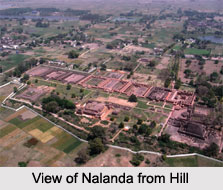 Nalanda was the seat of learning in the early era of Indian history. It is evident from the large numbers of texts that Yijing carried back with him after his 10 year residence at Nalanda, that Nalanda had featured a well-equipped library.
Nalanda was the seat of learning in the early era of Indian history. It is evident from the large numbers of texts that Yijing carried back with him after his 10 year residence at Nalanda, that Nalanda had featured a well-equipped library.
Tibetan Sources in Nalanda
The traditional Tibetan sources mention the existence of a great library at Nalanda named Dharmaganja which comprised three large multi-storeyed buildings, the Ratnasagara (Ocean of Jewels), the Ratnodadhi (Sea of Jewels), and the Ratnaranjaka (Jewel-adorned). Ratnodadhi was nine storeys high and housed the most sacred manuscripts including the Prajnyaparamita Sutra and the Guhyasamaja.
Collections in Library of Nalanda
The exact number of volumes in the Nalanda library is not known. But it is estimated to have been in the hundreds of thousands. The library not only collected religious manuscripts but also had texts on such subjects as grammar, logic, literature, astrology, astronomy and medicine.
Classification of Ancient Texts in Nalanda
The ancient library of Nalanda University must have had a classification scheme which was possibly based on a text classification scheme developed by the Sanskrit linguist, Panini. The Buddhist texts were most likely divided into three classes based on the Tripitaka`s three main divisions: the Vinaya, Sutra, and the Abhidhamma, are all collected by the Buddhists monks in Nalanda University. It is said that Nalanda had ample amount of books than Odantapuri and Vikramshila.
Nalanada according to the Chinese Travellers
The knowledge of Nalanda comes from the writings of pilgrim from East Asia such as Hiuen Tsang, Fahien and Yijing who travelled to Nalanda in the 7th century. Vincent Smith remarked a detailed history of Nalanda would be a history of Mahayanist Buddhism. Many of the names listed by Hiuen Tsang in his travelogue as products of Nalanda are the names of those who developed the philosophy of Mahayana. All students at Nalanda studied Mahayana as well as the texts of the eighteen (Hinayana) sects of Buddhism. Their curriculum also included other subjects such as the Vedas, Logic, Grammar, Philology, Medicine, Samkhya, law, astronomy, and City-Planning.
Decline of Nalanda
Nalanda was destroyed by an army of the Mamluk Dynasty under Bakhtiyar Khilji in 12th Century. While some sources note that the Mahavihara continued to function in a makeshift fashion for a while longer, it was eventually abandoned and forgotten until the 19th century when the site was surveyed and preliminary excavations were conducted by the Archaeological Survey of India.



















